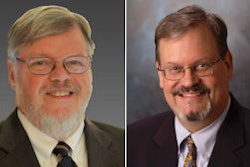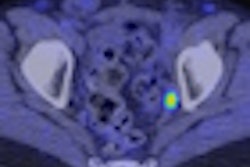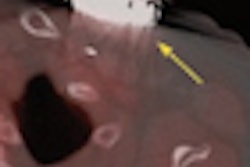
As nuclear medicine and molecular imaging become increasingly entwined, the Society of Nuclear Medicine (SNM) is looking to keep pace and expand its reach beyond the boundaries of the radioisotopes on which the medical specialty was founded.
At this year's annual meeting in Miami from June 9-13, SNM plans to take both symbolic and concrete steps into the future. One is a proposal to change the name of the organization, while the other is a global cooperation initiative to make nuclear medicine and molecular imaging more relevant to practitioners and patients.
 Dr. George Segall, SNM president.
Dr. George Segall, SNM president.
On June 11, SNM members will vote on a proposal to change the name of the organization to the Society of Nuclear Medicine and Molecular Imaging. Dr. George Segall, current SNM president, estimated that approximately 75% of the membership is in favor of the name change, following approval by the House of Delegates at SNM's winter meeting in January.
"We feel the [new name] accurately reflects the evolution of the field, as well as the society, to image physiology at the molecular and cellular level, rather than at the organ level, as we have done traditionally in the past," said Segall, who also serves as chief of nuclear medicine service at the Veterans Affairs Palo Alto Health Care System. He is also a professor of radiology at Stanford University.
Global cooperation
In addition, the global cooperation theme of this year's annual meeting is designed to advance the field of nuclear medicine and molecular imaging and improve patient health benefits worldwide.
"Nuclear medicine is a relatively small specialty, but through global cooperation we can leverage our resources and unique strengths for the benefit of patients throughout the world," Segall said. "We feel we can do this effectively in making sure that education is widely available and in the standardization of research protocols, so that clinical trials are performed in such a way that the results can be aggregated for greater statistical power."
New radiopharmaceuticalsSegall plans to outline four key elements of the global cooperation initiative in his president's address on June 10. The first theme is the development and promotion of new radiopharmaceuticals.
For example, last month the U.S. Food and Drug Administration (FDA) approved the radiopharmaceutical florbetapir to view amyloid plaque in the brain, which has been linked to Alzheimer's disease and dementia. Eli Lilly markets the PET imaging agent under the brand name Amyvid.
SNM last month began a partnership with the Alzheimer's Association to develop appropriate-use criteria to help physicians understand when Amyvid should and should not be used. While the Alzheimer's Association has expressed its support for the FDA's clearance of the radiopharmaceutical for Alzheimer's diagnosis, treatment, and prevention, the organization referred to use of the radiopharmaceutical as a "double-edged sword" in a prepared statement.
The association cautioned that potential uses of the product "are not crystal clear [which] tempers our enthusiasm. Again, additional research is needed to clarify the role of florbetapir-PET imaging in Alzheimer's."
"This is a potentially very useful radiopharmaceutical and we feel the Society of Nuclear Medicine has a unique role to educate referring physicians, patients, and payors about the appropriate use and value," Segall added. "Only after there is more education and outreach will we think that the test will be more widely adopted by the radiology community and other specialists who use nuclear medicine as a tool."
Radioisotope therapy
The second element of the global cooperation campaign is radioisotope therapy. Currently, few specialists, other than nuclear medicine physicians, use radioisotope therapy. Segall noted that most nuclear medicine in the U.S. is practiced by radiologists, whose practice is limited to radioiodine therapy of hyperthyroidism and, in some cases, thyroid cancer.
He advocated that specialists receive the necessary on-the-job training to take advantage of effective radiopharmaceuticals that may be less familiar to general practitioners. He cited the example of liver tumors, which could be treated with chemoembolization, radiofrequency ablation, and/or radioactive microspheres.
"Nuclear medicine physicians and radiologists can gain the necessary experience on the job to use these therapies, but they have often been overlooked because the training is usually not incorporated in many training programs," Segall said. "We feel that the society has a role to promote awareness of the therapies, to provide the education to use them appropriately and safely, and then to promote the therapies."
Hybrid modalities
The progression of new hybrid molecular imaging technologies will also play a role in global cooperation. PET/MR, for example, has garnered great interest over the past two years, but its place in clinical practice remains somewhat vague. The adoption of PET/MR as part of standard clinical practice may be difficult, Segall said, unless there is evidence to support its benefit to patients.
"Reimbursement will depend on evidence showing that using this technology results in incremental benefits," he added. "Incremental benefits have to be defined; they are different for different patients with different diseases. It is complicated, but in this economy with the concern of rising healthcare costs, we have to make sure that what we are advocating is cost-effective and delivers real benefits to people."
Value
The fourth element of global cooperation is value. While it is a somewhat general term, Segall said value is directed toward improved healthcare for patients and proving the value of nuclear medicine and molecular imaging through evidence-based research.
"It is very difficult and very expensive to do clinical trials," Segall added. "Many times, evidence is developed through systematic reviews of literature and meta-analyses, but the problem with these types of instruments is that the clinical research that is done outside of standardized clinical trials often employs different criteria for response evaluation."
SNM wants to standardize protocols for data acquisition and processing, and it recommends the adoption of universal measures so results can be more effectively evaluated and correlated into the medical evidence that's needed to support reimbursement.
Radiation exposure
SNM also plans to promote its latest initiative on the issue of radiation exposure and safety. The organization joined the Choosing Wisely campaign to provide patients with more information on frequently performed procedures, as well as information on what questions patients should ask their doctors about the appropriateness of radiation use.
SNM has also created a patient advisory board, which meets with the organization at the midwinter meetings and maintains contact through conference calls during the year. The forum provides an opportunity to work with these groups to educate them about appropriate use of nuclear medicine and molecular imaging procedures, along with radiation safety issues.
"The best way to reduce radiation exposure is not to perform an unnecessary diagnostic test," Segall said. "We also want to dispel unfounded fears about having tests that are appropriate, because these tests are really very safe. Sometimes the public has misunderstood the theoretical risks, and we are afraid that the lack of deeper understanding will cause patients and referring physicians to use less accurate tests inappropriately due to unfounded concerns about radiation."




















